|
|
|
Introduction
Shaw was established during the second world war by the Marconi-Osram Valve Company, a division of the General Electric Company of England, as a shadow factory for the electronic valves and cathode ray tubes being made at Hammersmith. Soon after the war it shifted focus to concentrate on the manufacture of the company's fluorescent tubes, and thereafter the high technology discharge lamps. Especially following its takeover by the German Osram company it prospered for many years, but sadly is success came to an end following the obsolescence of one of its major products, the low pressure sodium lamp. Continued existence to produce the other lamp types was not deemed viable, and the factory was closed in 2000.
|
 View of Duke Mill in 1997, shortly after renovation and looking at its best
View of Duke Mill in 1997, shortly after renovation and looking at its best
|
| Address |
Refuge Street, Shaw, Oldham, OL2 8RJ, United Kingdom. |
| Location |
Duke Mill: 53.5748°N, -2.9027°E. Cape Mill: 53.5733°N, -2.9039°E.
|
| Opened |
1939-45 |
| Closed |
2000 |
| Products |
Electronic Valves, Cathode Ray Tubes, Vacuum Incandescent, Automotive Incandescent, Linear Fluorescent, Low Pressure Sodium, High Pressure Sodium, Medium Pressure Mercury, High Pressure Mercury, Short Arc Mercury, Quartz Metal Halide, Short Arc Metal Halide, Linear Neon, Laboratory Spectral Sources. |
Early History
Soon after the outbreak of the Second World War, it was noted that the GEC's manufacturing of electronic valves and cathode ray tubes at Hammersmith was of strategic military importance to the war effort, and the risk could not be taken that this crucial facility might be bombed. It was therefore decided to establish a shadow factory in the relatively safe north-western part of the country, and suitable facilities were identified in the small town of Shaw. Sometime during the period 1939-45 the M-O Valve Company purchased two former mills from the Lancashire Cotton Corporation for the princely sum of £7000, and these were converted for the manufacture of electronic tubes. The two sites were known by their former names, Cape Mill and Duke Mill, and production was initially set up in Cape. A plethora of different tubes then made the journey northwards, including such products as the GEC's famous KT66 Kinkless Tetrode, still today one of the most revered electronic valves among professional audiophiles.
After the end of hostilities it was only natural that production should return to the original site at Hammersmith, and for a while the future looked bleak for Shaw. However another new product was to come to its rescue. In 1936 the GEC's Hirst Research Centre at Wembley developed the world's first hot-cathode fluorescent discharge lamp, and demonstrated it among others to a visiting party from General Electric of USA. GE was the first win the battle of refining the design into a production-ready model, and launched the world's first commercial fluorescent tubes in 1938. A little later that year the GEC also established its own production, of a 3' 30W model at Hammersmith Lampworks, but manufacturing was promptly suspended and the lamp re-engineered owing to the imminence of war. It was no longer conceivable to introduce a complete new lighting system that required the establishment of manufacturing of a new type of 30-watt magnetic ballast, along with the special bi-pin lamp caps and holders that the Americans had developed. Instead the lamp design was adjusted to make use of the existing bayonet caps of incandescent lamps, along with the 80-watt ballast of the high pressure mercury lamp. This resulted in the oddity of the 5-foot 80-watt BC-capped British fluorescent lamp, whose tremendous improvement in light-generating efficiency over the incandescent lamp saw it make inroads into the lighting of many of the wartime factories, which needed large amounts of cheap light.
By the end of the war the fluorescent section at Hammersmith was becoming increasingly cramped, and to cope with rapidly booming demand a large factory space was needed which offered the necessary potential for future expansion. At that moment it must surely have been contemplated to shift the manufacturing out to the nearby town of Wembley, where in 1930 the GEC had built a state-of-the-art factory to take over its high volume incandescent lamp production, along with substantial facilities for the manufacturing of glass, tungsten, and other materials required by the lamp industry. However Shaw also offered the necessary facilities and already had a work force well-trained in the manufacture of glass electrical devices, which would become available after its valve and CRT manufacturing returned to Hammersmith. And so it was that Duke Mill, which had remained largely empty until that point, was adapted to progressively take over the mass-production of fluorescent lamps while the valve production in Cape Mill came to an end.
Following the success of the transfer, it was decided that the sprawling Hammersmith site should concentrate solely on the manufacture of electronic tubes. Following its divestiture of the bulk of the incandescent volume to Wembley and fluorescent to Shaw, only a few small special lamp departments that remained. It was only logical that the remaining discharge technologies, based on sodium and mercury vapour, should also join the fluorescent discharge lamps at Shaw. In addition to these, some incandescent groups engaged in the manufacturing of vacuum and automotive lamps also made the journey to Shaw, these being classed as specials, which allowed Wembley to concentrate on the most important business of the high-volume manufacture of the more popular incandescent types. It was in particular the high technology of the most advanced category of light sources, the high intensity discharge family, that was to fuel a many decades of lighting leadership from the small northern town of Shaw.
|
Fluorescent Relocation
The fluorescent business boomed as expected, and before long it became clear to the directors of the GEC that it was time for a third relocation. Especially following the vast investments made in fluorescent manufacturing by its rivals, Thorn Lighting of Enfield, GEC was falling behind and quickly becoming uncompetitive. New machinery was required to manufacture lamps horizontally rather than the traditional vertical method, and for optimum efficiency it was desirable to arrange the entire manufacturing process in a straight line with one machine feeding directly into the next.
The available linear floor space as well as the architectural limitations of the old mills at Shaw must have presented considerable obstacles to the desires of the manufacturing engineers, and ultimately it was decided that a new site was necessary. In 1968 GEC purchased a dedicated new horizontal line for making 4-foot 40W T12 tubes from the British builder of lampmaking machinery, Badalex Automation, and this was set up at new factory on a modern industrial estate, in the nearby town of St. Helens.
It is not known precisely when the fluorescent manufacturing ended at Shaw, but it is likely that it continued into the late 1970s. Certainly in 1975 GEC was still operating just the single 4' T12 line at St. Helens, which had a second line capable of making 5' and 6' lamps on order. The other tube lengths and diameters were presumably therefore still being made at Shaw. It has also been speculated that Shaw may still have been making fluorescent lamps as late as 1990, when Osram-GEC manufactured its last batch of 5-foot 80W T12 lamps having the original bayonet end caps.
|
Discharge Developments
Without doubt the most important category of lamps that was transferred to Shaw was the high intensity discharge family. At first the range consisted only of the earliest types that had been developed at Hammersmith, i.e. the Medium Pressure MA mercury lamps, and the Low Pressure SO/H sodium lamps.
In later years Shaw went on to achieve numerous firsts and important achievements, often in conjunction with technical support from the company's central research laboratories at Wembley. These included:
* The modern low pressure sodium lamp having an integral outer jacket
* The first application of metallic thin-film heat reflectors to low pressure sodium lamps
* The manufacturing of the first high pressure sodium lamps in Europe
* Development of water-based techniques for the application of phosphor coatings
* Important breakthroughs in the performance of short-arc metal halide lamps.
In addition, developments in manufacturing processes and equipment kept the company at the forefront of discharge lamp technology for many years, and tremendous advances were made in particular for the manufacturing of low and high pressure sodium types.
|
Takeover by Osram of Germany
The history of the German Osram company is particularly complex, perhaps none more so than in the case of its British operations. The origins of Osram in England can be traced back to 1907, when Hugo Hirst of GEC desired to establish the first manufacturing of tungsten filament lamps in Britain. The technology for these lamps was developed on the continent, and in that year he set up a joint company with the Auer-Gesellschaft, one of the predecessors of the present-day Osram, to manufacture tungsten lamps at Hammersmith.
The operations prospered, but of course at the outset of the first world war, all enemy assets were confiscated. Osram lost its shareholding in the British operation as well as the rights to its brand name, a situation which was repeated in many other countries around the world. In 1916 Hirst had the opportunity to buy out this share from the Custodian of Enemy Property, and from that point onwards the company became entirely British-owned and Independent. Many years after the war Osram's parent company, Siemens, had rebuilt itself as a strong enterprise in Germany and was in a position to begin buying back many of its former overseas factories - only to have them confiscated for a second time at the outbreak of the second world war! Moreover its former headquarters and factories in the Eastern part of Germany were permanently lost to the Soviet invaders, who restructured all of the captured lampmaking firms, including the Osram parts, into the the present-day Narva company. This monumental setback for Osram took many more years of slow growth from its home market to recover from, and the second buy-back operations did not begin until 1962 when Osram was able to recover its former brand and factories in France, followed steadily by many of its other overseas territories.
Years of intense negotiations followed between Osram and GEC, but the directors of GEC made it clear that they would not entertain any ideas of selling any share of their immensely profitable Lighting division back to Osram. Eventually in 1967 Osram came to the realisation that if it wanted to get back into the lighting market of Britain and its colonies around the globe, it was going to have to do so by building the business up again from scratch - and in competition against the formidable GEC. As such it resurrected one of its old brand names, and formed the new company "Wotan Lamps Ltd." in Britain and many other countries around the world - the change of name back to this old Siemens brand being necessary because it had lost its rights to the Osram trademark following the confiscations during the war.
As the years went on, and particularly in the decades following the leadership of the GEC under Sir Arnold Weinstock, the mentality did began to change, and GEC became more interested in other electrical avenues. It had been under-investing in lamps and losing market share to its rivals, Thorn Lighting and Philips, and it must have been becoming clear that the Osram-GEC lighting division was simply too small to compete in the increasingly globalised markets. A decision was reached on 19th March 1986 whereby Osram acquired 49% of Osram-GEC - and thereby regained control of its brand name in Britain and the remaining countries of the world, which it had lost an incredible 72 years earlier! So momentous was the occasion that a large rock was placed outside the company's headquarters in Munich, specially engraved to mark the historic re-acquisition of the last of its former divisions which had been lost following two world wars. The shareholding was increased to 100% in 1990, when GEC finally made the decision to exit the lighting business.
|
Operations under Osram GmbH
The change of ownership must have been met with much trepidation at the former GEC factories. Indeed Osram GmbH wasted no time in shutting down the operations at Wembley and St. Helens, which had suffered from many years of under-investment and were simply too far behind Osram's European manufacturing facilities to be able to justify their continued existence.
Shaw, remarkably, was saved - possibly in no small measure thanks to the excellence it had built up in the manufacturing of sodium vapour lamps. Not only did the factory feature a remarkable arrangement for the large-scale production of high pressure sodium arc tubes, it was also skilled in the low pressure sodium lamps, an important category which was not present in the portfolio of German Osram. The site also brought strong competencies to the Osram group via the expertise of the staff at the on-site lamp development laboratories.
Perhaps the only major restructuring following the takeover was the decision that Shaw should concentrate solely on discharge lamps. The small incandescent group making 15W and 25W vacuum GLS lamps, as well as Pygmy indicator types, was relocated to an Osram factory in Italy which was more specialised in those products. At around the same time the old Cape Mill building was vacated and demolished - its chimney famously being brought down by Fred Dibnah, a steeplejack whose impressive demolitions formed part of a popular television series. The loss of the incandescent manufacturing was more than compensated for by the relocation of a number of special discharge lamps from Italy to Shaw - covering such special types as laboratory spectral sources, and the Ultra-Vitalux self-ballasted UV mercury lamp. Further transfers were also to benefit Shaw, in particular the shift of Osram's prestigious Oscar-winning HMI short arc metal halide lamps from Germany. At one time in the mid 1990s it was even proposed to establish the production of energy-saving compact fluorescent lamps at Shaw, although that plan did not materialise.
In addition to the investments in new manufacturing, the company also invested heavily in the infrastructure of the site. Major renovations and restorations were carried out, which have left Duke Mill as arguably one of the best maintained former cotton mills in the entire North of England.
Its fortunes were to take a downward turn only when one of its major products, the low pressure sodium lamp, began to approach the end of its commercial lifetime in the late 1990s. Volumes of that light source were beginning to give way to the high pressure sodium version, which although slightly less efficient, has a considerably longer lifetime and thus means less investment in maintenance for street lighting authorities. Low pressure sodium accounted for a considerable portion of the overheads at Shaw, and its loss sadly brought the factory into a position of losing its economic viability. In 2000 production came to an end. The production of many lamps was transferred to Osram's other factories elsewhere in Europe and Asia, while the low pressure sodium was abandoned and Osram began to source those types in from Philips at Hamilton.
|
Photographs
|
 |
|
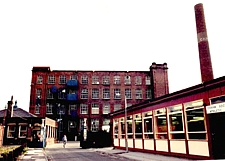 |
|
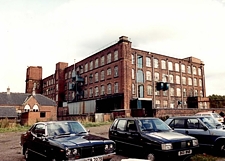 |
|
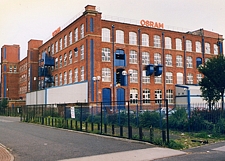 |
| Cape Mill Factory, 1948 (1) |
|
Cape Mill Factory, c. 1980 (6) |
|
Duke Mill Factory, c. 1980 (6) |
|
Duke Mill after renovation, 1997 |
|
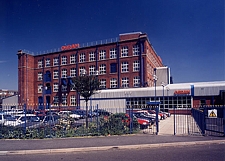 |
|
 |
|
 |
|
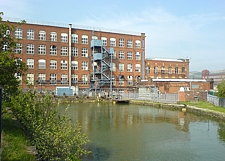 |
| Duke Mill after renovation, 2000 (6) |
|
Duke Mill after closure, 2007 (4) |
|
Duke Mill after closure, 2007 (4) |
|
Duke Mill water reservoir, 2007 (4) |
|
 |
|
|
|
|
|
|
| Aerial View of Duke & Cape sites 2005 |
|
|
|
|
|
|
Photographs - Fluorescent Section
|
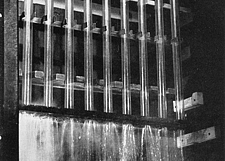 |
|
 |
|
 |
|
 |
| Washing the Glass Tubes, 1952 (5) |
|
Coating with Phosphor, 1948 (1) |
|
Coating with Phosphor, 1952 (5) |
|
Cleaning Tube Ends, 1948 (1) |
|
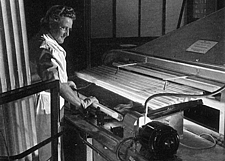 |
|
 |
|
 |
|
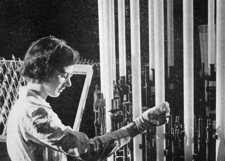 |
| Baking the Phosphor, 1952 (5) |
|
Glass Stem Making, 1952 (5) |
|
Electrode Mounting , 1948 (1) |
|
Sealing Electrode into Tube, 1952 (5) |
|
 |
|
 |
|
 |
|
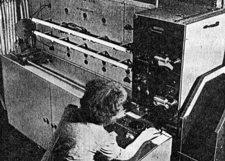 |
| Rotary Exhaust Machine, 1948 (1) |
|
Rotary Exhaust Machine, 1952 (5) |
|
Capping and Ageing, 1952 (5) |
|
Finished Lamp Testing, 1948 (1) |
|
 |
|
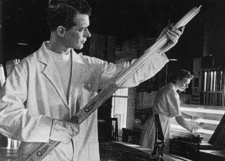 |
|
|
|
|
| Finished Lamp Testing, 1952 (5) |
|
Finished Lamp Packing, 1952 (5) |
|
|
|
|
Photographs - Low Pressure Sodium Section
|
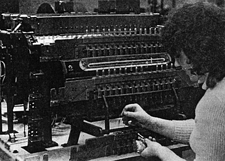 |
|
|
|
|
|
|
| Emitter Coating of SOX Cathodes (8) |
|
|
|
|
|
|
Photographs - High Pressure Sodium Section
|
 |
|
 |
|
 |
|
 |
| SON - Radyne HF Arc Tube Sealing (7) |
|
SON - Arc Tube Test by Tesla Coil (7) |
|
SON - Mount Assembly Inspection (7) |
|
SON - Ageing of Finished Lamps (7) |
Examples of Shaw Lamps
Low Pressure Sodium - U-Shape
|
 |
|
 |
|
 |
|
 |
|
 |
|
 |
| SO/H 45W |
|
SO/H 140W |
|
SOI/H Integral 45W |
|
SOI/H Integral 85W |
|
SOI/H Integral 140W |
|
SOI/H Twin Arc 280W |
|
 |
|
 |
|
 |
|
 |
|
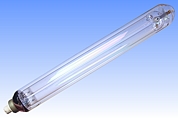 |
|
 |
| SOI Experimental 140W |
|
SOXv1 Tin Film 40W |
|
SOXv2 Indium Film 90W |
|
SuperSOX v3 55W |
|
SuperSOX v4 90W |
|
SuperSOX v5 55W |
|
 |
|
 |
|
 |
|
 |
|
|
|
|
| SOX-Plus v6 35W |
|
SuperSOX 18W |
|
SuperSOX 10W |
|
SOX-E 26W |
|
|
|
|
Low Pressure Sodium - Linear
|
 |
|
 |
|
 |
|
 |
|
 |
|
|
| SLI Golden Linear 60W |
|
SLI Golden Linear 175W |
|
SLI/H Linear 60W |
|
SLI/H Linear 160W |
|
SLI/H Linear 200W |
|
|
High Pressure Sodium
|
 |
|
 |
|
 |
|
 |
|
 |
|
 |
| SON-I Int. Ignitor 310W |
|
SON-I Int. Ignitor 120W |
|
SON-L Linear 250W |
|
SON-R Reflector 310W |
|
SONDL-T Deluxe 400W |
|
SONP-T Plus 310W |
|
 |
|
|
|
|
|
|
|
|
|
|
| SONP Experimental 70W |
|
|
|
|
|
|
|
|
|
|
High Pressure Mercury
|
 |
|
 |
|
 |
|
 |
|
 |
|
 |
| MA/V Hard Glass 400W |
|
MB/U Quartz 250W |
|
MB/U Frosted 125W |
|
MBF Germanate 80W |
|
MBF Vanadate 1000W |
|
MBFR Reflector 125W |
Metal Halide
|
 |
|
 |
|
 |
|
 |
|
|
|
|
| MBI\H White 2000W |
|
MBI\U Blue 400W |
|
MEI Coolseal 575W |
|
MEI Supercool 2500W |
|
|
|
|
Fluorescent
|
 |
|
|
|
|
|
|
|
|
|
|
| Bayonet Cap 5' 80W |
|
|
|
|
|
|
|
|
|
|
Special Discharge
|
 |
|
 |
|
 |
|
 |
|
 |
|
|
| NE/H Linear Neon 400W |
|
Spectral Sodium |
|
Spectral Mercury |
|
Spectral Cadmium |
|
Spectral Merc.-Cad. |
|
|
| 1 |
Fluorescent Lamp Manufacture at Shaw, The Engineer April 23 1948 pp.396-398. |
| 2 |
The GEC Research Laboratories 1919-1984, Sir Robert Clayton & Joan Algar, Peregrinus Ltd., ISBN 0 86341 146 0. |
| 3 |
History of the Marconi-Osram Valve Company, Wikipedia. |
| 4 |
List of Mills in Shaw and Crompton, Wikipedia. |
| 5 |
Osram Lamps In the Making, 1952. |
| 6 |
Historic Photographs of Osram-GEC in England, John Reeves. |
| 7 |
Osram-GEC Brochure, Solarcolour High Pressure Sodium Lamps, 1985. |
| 8 |
Continuing Development at Osram-GEC Shaw, Light & Lighting March/April 1975, pp.83-84 |
| 9 |
Private Communication, Graham Skeldon - Osram Wembley, 1995. |
|
|
|
|
|